
- All Instrument Types
- Indices
- Equities
- ETFs
- Funds
- Commodities
- Currencies
- Crypto
- Bonds
- Certificates
Please try another search

Manulife Financial: Stock Growth Hinges On Rate Outlook, Asset Management Division

Manulife Financial (NYSE:MFC) is the largest insurance company in Canada by total assets. Along with various types of insurance, including annuities, the company provides a range of money management services.
MFC is planning for much of its growth to come from its Wealth and Asset Management (WAM) side. The low-interest environment in recent years has been hard on insurance companies and MFC is no exception. Uncertainty on the interest rate outlook is constraining earnings expectations for MFC.
Manulife is well-diversified geographically and much of the anticipated growth in both the insurance and WAM business is expected to come from Asia. Globally, MFC’s WAM businesses exceed $1 trillion dollars in assets under management and administration. Looking forward, the bull narrative for MFC depends on rising interest rates and substantial growth in WAM.
After closing at a YTD high of $22.16 on May 5, the shares have fallen 10% to reach the current price of $19.91. Having closed on Dec. 31, 2020 at $17.82, the shares are up 11.7% for the YTD.
Source: Investing.com
Over longer periods of time, MFC’s total returns have been lackluster and the 15-year total return is slightly negative. More recently, over 1-, 3-, and 5-years, MFC has solidly outperformed the Life Insurance industry, although these returns are far below those provided by the U.S. equity market and the U.S. financial sector.
The iShares U.S. Financials ETF (NYSE:IYF) has returned more than 13% per year over the past 3-, 5-, and 10-year periods, for example.
Source: Morningstar
MFC is a value stock, with TTM P/E of 6.9 and 4.5% dividend yield. The P/E ratio has been very stable since the end of 2018. Over the past 3- and 5-year periods, the annualized dividend growth rate is about 11%. From the perspective of the Gordon Growth Model, MFC should have expected returns of around 15% if the trailing dividend growth rate can be extrapolated forward.

Source: Macrotrends.com
Neither MFC nor its industry are typically regarded as having a lot of growth potential. The stock’s trailing total returns are not going to get the attention of investors in the current bull market. Based on the trailing P/E, MFC does not look undervalued relative to recent years.
To formulate a view on MFC, I rely on two forms of consensus outlooks. The first is the well-known consensus rating and 12-month price target from Wall Street analysts. The second is the market-implied outlook, the consensus view of the options market as reflected in the prices of call and put options at a range of strike prices.
The price of an option represents the market’s consensus view of the probability that the price will rise above (call option) or fall below (put option) a specific level (the strike price) from today until the option expiration date. By analyzing calls and puts at a range of strikes and a common expiration date, it is possible to infer the options market’s aggregate view of the probabilities of possible price returns between now and the expiration date.
For those who are unfamiliar with this concept, I have written an overview post, including links to the relevant financial literature.
Wall Street Consensus Outlook for MFC
eTrade’s calculation of the Wall Street consensus outlook combines the views of 10 ranked analysts who have published opinions within the past 90 days. The consensus rating is bullish and the consensus 12-month price target is 27.4% above the current price. Even the lowest of the analyst price targets is 6.9% above the current price. The price appreciation implied from the consensus price target is slightly under the 12-month trailing return but far above longer-term historical returns.
Source: eTrade
Investing.com’s version of the Wall Street consensus aggregates the views of 8 analysts. The consensus rating is bullish and none of the analysts gives MFC a rating below neutral. The consensus 12-month price target is 22.4% above the current price.
Source: Investing.com
Market-Implied Outlook for MFC
I have analyzed call and put option prices at a range of strikes and two expiration dates. The options expiring on Jan. 21, 2022 provide a market-implied outlook for the next 4.74 months and those expiring on Mar. 18, 2022 provide a market-implied outlook for the next 6.57 months. I analyzed options with these two expiration dates to provide a view to early 2022 and then to check for consistency in the market implied outlook for a slightly longer period.
The standard presentation of the market-implied outlook is a probability distribution of price return, with probability on the vertical axis and price return on the horizontal.
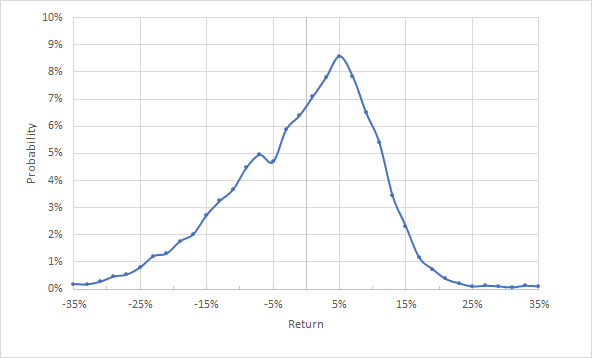
Source: author’s calculations using options quotes from eTrade
The market-implied outlook for the next 4.74 months is significantly tilted to favor positive price returns. The peak probability corresponds to a price return of 5% over this period. The median price return from this distribution (50% probability of having a return above / 50% probability of having a return below) is 1%. The annualized volatility derived from this market-implied outlook is 24%. This is quite low for an individual stock. This market-implied outlook is significantly bullish.
To make it easier to compare the probabilities of positive and negative returns of the same magnitude, I rotate the negative return side of the distribution about the vertical axis (see chart below).
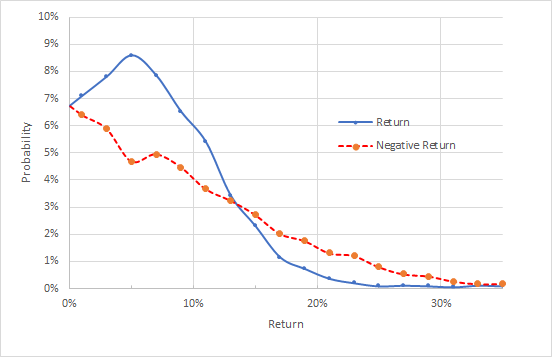
The negative side of the distribution has been rotated about the vertical axis (Source: author’s calculations using options quotes from eTrade)
This view shows that the probability of having a positive return is substantially higher than for a negative return for a range of the most probable outcomes (returns in the range +/-10%), which supports a bullish view. For large-magnitude returns (+/-15% or larger) the probability of negative returns is higher than for positive returns but these are, overall, low-probability outcomes.
One limitation in interpreting the market-implied outlook for MFC is that the option trading on this stock is light. This reduces confidence in the meaningfulness of the outlook. When I analyzed the options expiring in March, however, the outlook is qualitatively the same, with a strong tilt in probability towards positive price returns.
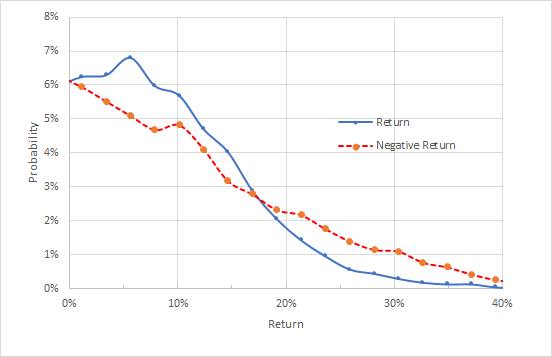
The negative side of the distribution has been rotated about the vertical axis (Source: author’s calculations using options quotes from eTrade)
Over this longer time horizon, the peak probability is for a price return of 5.6% and the annualized volatility is 23%. This bullish market-implied outlook is reassuring, but the overall confidence in the results is modest due to the light options trading.
Summary
Recent years have been challenging for insurance companies, largely due to low interest rates. MFC has responded to this business environment by focusing on expanding Wealth and Asset Management (WAM), a group of business lines with higher margins.
The shares are cheap compared to current earnings but higher multiples rely on evidence for faster earnings growth. As yet, the market appears unconvinced.
The consensus opinion of the equity analysts who follow MFC is remarkably bullish, however, with expected 12-month price appreciation above 20%. The market-implied outlook for MFC to early 2022 is also bullish, with the peak probability price return at 5%-6% over the next six months. The annualized volatility derived from the options is about 24%.
Taking the analyst consensus price target at face value, MFC has expected price return of 20%+ with volatility of 24%. I consider expected return for a stock that is greater than ½ the volatility to be attractive, so MFC looks like a strong buy.
Tempering that bullish view, however, there is considerable uncertainty in when interest rates will rise. The market-implied outlook is also bullish, stock has moderate expected volatility and, let’s not forget, a 4.5% dividend yield. I partially discount the market-implied outlook due to low levels of options trading activity. I am bullish overall, but I don’t expect a price return as high as the analyst consensus.
Related Articles

Using the Elliott Wave Principle (EWP), we have been tracking the most likely path forward for the Nasdaq 100 (NDX). Although there are many ways to navigate the markets and to...

Investors are on edge about what tariff policy means for markets Coming off a strong Q4 earnings season, fresh February corporate sales figures can help assess the macro...

Broadcom stock is in a dynamic rebound phase. Markets seem optimistic ahead of the earnings release. Let's take a deep dive into what to expect from the report. Get the...
Are you sure you want to block %USER_NAME%?
By doing so, you and %USER_NAME% will not be able to see any of each other's Investing.com's posts.
%USER_NAME% was successfully added to your Block List
Since you’ve just unblocked this person, you must wait 48 hours before renewing the block.
I feel that this comment is:
Thank You!
Your report has been sent to our moderators for review






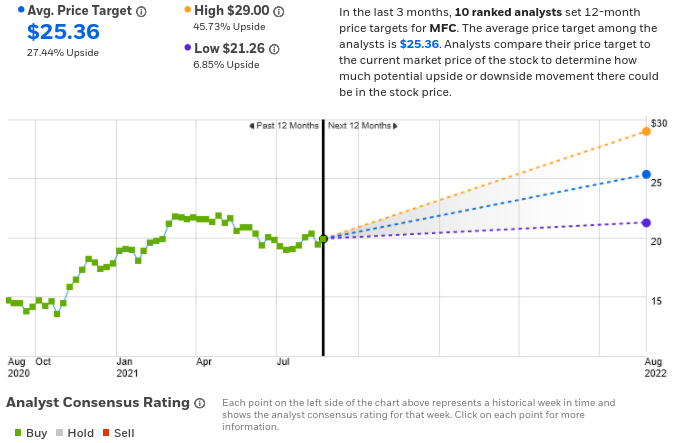
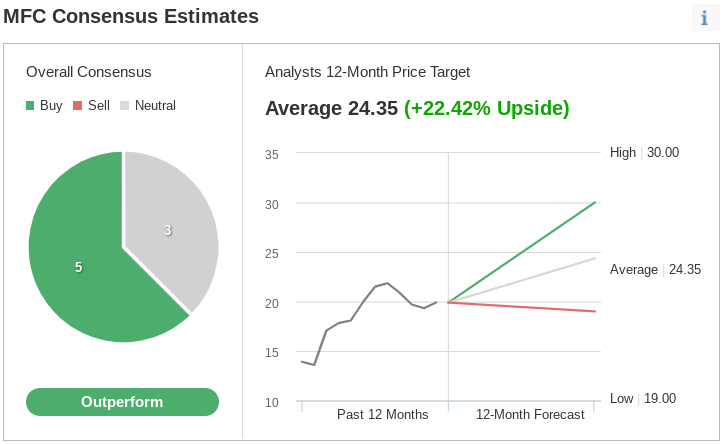

Add a Comment
We encourage you to use comments to engage with users, share your perspective and ask questions of authors and each other. However, in order to maintain the high level of discourse we’ve all come to value and expect, please keep the following criteria in mind:
Perpetrators of spam or abuse will be deleted from the site and prohibited from future registration at Investing.com’s discretion.